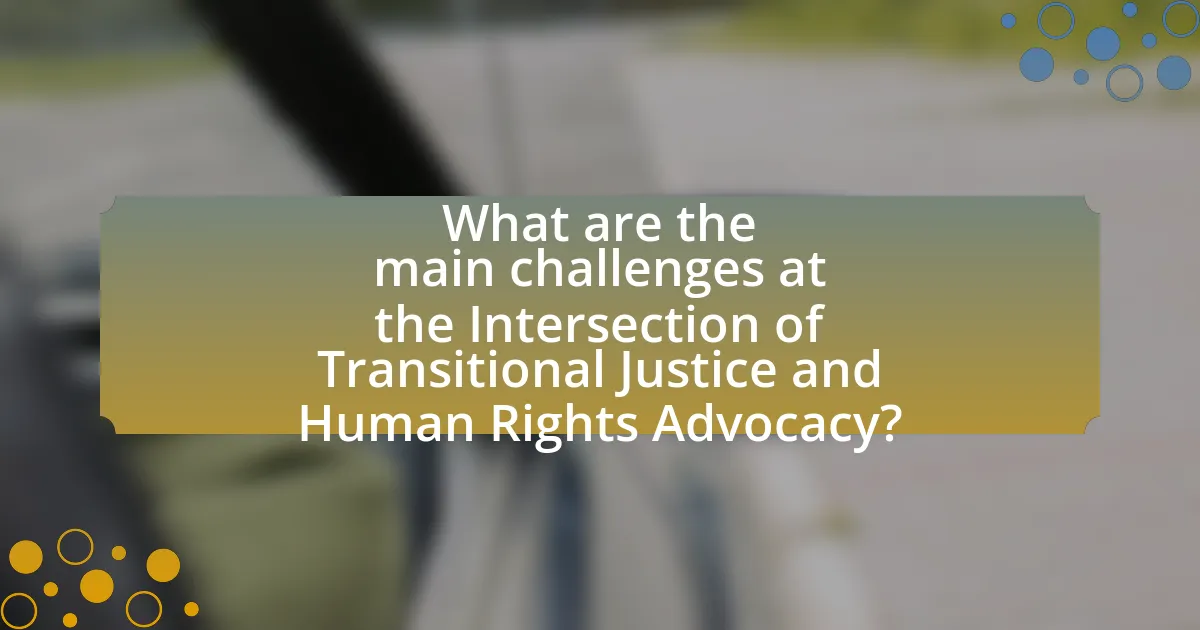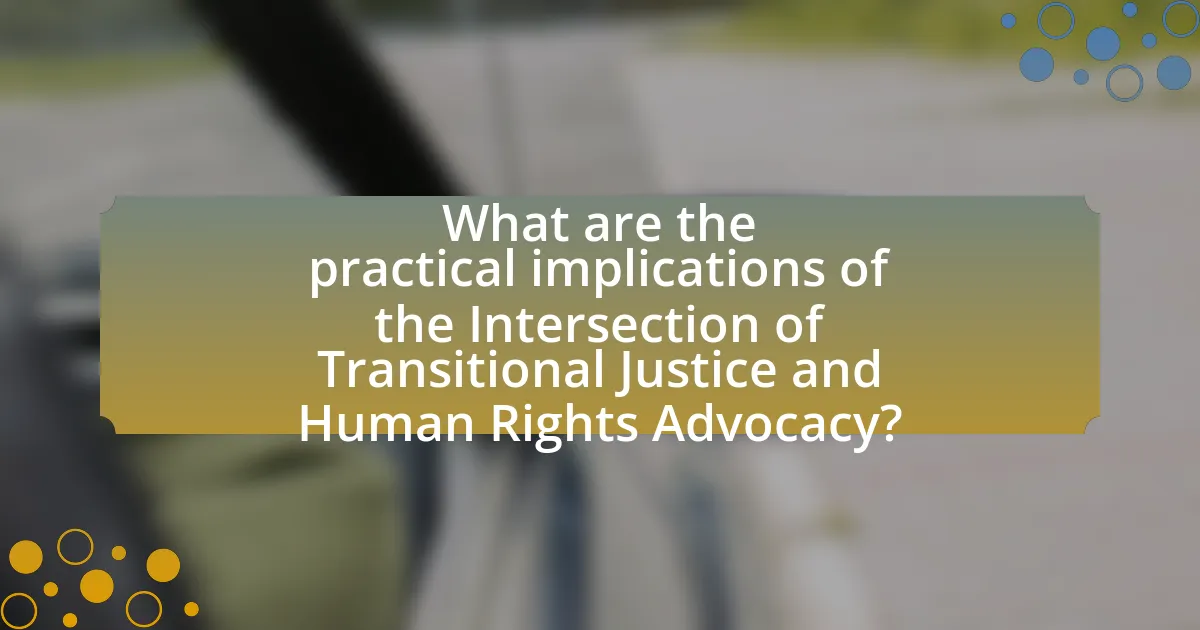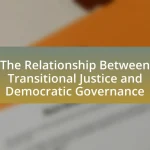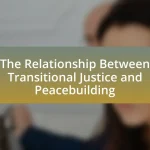The article examines the intersection of transitional justice and human rights advocacy, highlighting their shared objectives of addressing past human rights violations and promoting accountability, reconciliation, and the rule of law. It discusses key principles of transitional justice, such as accountability, truth-seeking, reparations, and institutional reform, alongside fundamental aspects of human rights advocacy, including awareness-raising and grassroots mobilization. The article also addresses the significance of their intersection in fostering accountability for past atrocities, the challenges faced in integrating these fields, and the practical implications for victims of human rights violations. Furthermore, it outlines strategies for enhancing collaboration and ensuring a victim-centered approach, while providing resources and training opportunities for practitioners in this domain.

What is the Intersection of Transitional Justice and Human Rights Advocacy?
The intersection of transitional justice and human rights advocacy lies in their shared goal of addressing past human rights violations and promoting accountability, reconciliation, and the rule of law. Transitional justice mechanisms, such as truth commissions and reparations, are designed to address the legacies of conflict and authoritarian regimes, while human rights advocacy focuses on protecting individuals’ rights and preventing future abuses. For instance, the Truth and Reconciliation Commission in South Africa aimed to uncover the truth about apartheid-era abuses, which aligns with human rights advocacy by fostering accountability and healing within society. This synergy enhances the effectiveness of both fields in promoting justice and safeguarding human rights.
How do Transitional Justice and Human Rights Advocacy relate to each other?
Transitional justice and human rights advocacy are interconnected as both aim to address past human rights violations and promote accountability, justice, and reconciliation in post-conflict societies. Transitional justice mechanisms, such as truth commissions and reparations, are designed to acknowledge and rectify injustices, which aligns with the goals of human rights advocacy that seeks to protect individuals from future abuses. For instance, the Truth and Reconciliation Commission in South Africa not only documented human rights violations but also contributed to the broader human rights discourse by emphasizing the need for systemic change and protection of rights. This relationship underscores that effective transitional justice processes can enhance human rights advocacy by fostering a culture of accountability and respect for human dignity.
What are the key principles of Transitional Justice?
The key principles of Transitional Justice include accountability, truth-seeking, reparations, and institutional reform. Accountability ensures that perpetrators of human rights violations are held responsible, which is essential for restoring trust in the rule of law. Truth-seeking involves uncovering the facts about past abuses, often through truth commissions, to provide a historical record and promote healing. Reparations address the harm suffered by victims, offering compensation or restitution to acknowledge their suffering. Institutional reform focuses on changing the structures that allowed abuses to occur, aiming to prevent future violations. These principles are foundational in promoting justice and reconciliation in societies transitioning from conflict or authoritarian rule.
What are the fundamental aspects of Human Rights Advocacy?
The fundamental aspects of Human Rights Advocacy include awareness-raising, legal support, policy influence, and grassroots mobilization. Awareness-raising involves educating the public and stakeholders about human rights issues, which is essential for fostering a culture of respect and accountability. Legal support provides individuals and communities with the necessary resources to seek justice and redress for human rights violations, often through litigation or legal representation. Policy influence aims to shape laws and regulations that protect human rights, ensuring that governments uphold their obligations under international human rights treaties. Grassroots mobilization engages communities in advocacy efforts, empowering them to demand their rights and hold authorities accountable. These aspects collectively contribute to the promotion and protection of human rights globally, as evidenced by the success of various human rights organizations in effecting change through these strategies.
Why is the intersection of these two fields significant?
The intersection of transitional justice and human rights advocacy is significant because it fosters accountability for past atrocities while promoting the protection of individual rights. Transitional justice mechanisms, such as truth commissions and reparations, aim to address historical injustices and provide a framework for healing societies. Human rights advocacy ensures that these processes uphold the dignity and rights of victims, thereby reinforcing the rule of law and preventing future violations. For instance, the establishment of the International Criminal Court has been pivotal in holding perpetrators accountable, demonstrating the effectiveness of integrating these two fields in promoting justice and safeguarding human rights.
How does this intersection impact victims of human rights violations?
The intersection of transitional justice and human rights advocacy significantly impacts victims of human rights violations by providing mechanisms for accountability and redress. Transitional justice processes, such as truth commissions and reparations programs, aim to address past abuses and promote healing for victims. For instance, the Truth and Reconciliation Commission in South Africa facilitated public testimonies from victims, which not only validated their experiences but also contributed to national healing and acknowledgment of injustices. Furthermore, human rights advocacy ensures that victims’ voices are included in these processes, enhancing their agency and promoting a more inclusive approach to justice. This intersection ultimately fosters a societal commitment to preventing future violations by establishing a historical record and promoting rule of law.
What role does this intersection play in promoting accountability?
The intersection of transitional justice and human rights advocacy plays a crucial role in promoting accountability by establishing mechanisms that address past human rights violations. This intersection facilitates the implementation of truth commissions, reparations, and legal proceedings, which are essential for holding perpetrators accountable and providing justice to victims. For instance, the Truth and Reconciliation Commission in South Africa successfully documented human rights abuses during apartheid, leading to public acknowledgment and legal actions against offenders. Such mechanisms not only promote individual accountability but also foster societal healing and the rule of law, reinforcing the importance of human rights in post-conflict societies.

What are the main challenges at the Intersection of Transitional Justice and Human Rights Advocacy?
The main challenges at the intersection of transitional justice and human rights advocacy include ensuring accountability for past human rights violations, balancing the needs for justice with the demands for peace, and addressing the complexities of societal reconciliation. Transitional justice mechanisms often face obstacles in holding perpetrators accountable due to political resistance, lack of resources, or insufficient legal frameworks, which undermines the effectiveness of human rights advocacy. Additionally, the pursuit of justice can conflict with peace negotiations, as some parties may prioritize stability over accountability, leading to compromises that may not fully address victims’ rights. Furthermore, achieving societal reconciliation is complicated by deep-seated divisions and mistrust within communities, making it difficult to foster a shared understanding of the past and promote healing.
What obstacles do practitioners face in integrating these fields?
Practitioners face several obstacles in integrating transitional justice and human rights advocacy, primarily due to differing objectives and methodologies. Transitional justice often focuses on accountability and reconciliation in post-conflict societies, while human rights advocacy emphasizes the protection of individual rights and freedoms. This divergence can lead to conflicts in priorities, where practitioners may struggle to align their approaches effectively.
Additionally, limited resources and funding can hinder collaboration between these fields, as organizations may prioritize their specific agendas over joint initiatives. A lack of interdisciplinary training among practitioners further complicates integration, as professionals may not possess the necessary skills to navigate both domains effectively.
Moreover, political resistance from state actors can obstruct efforts to implement transitional justice measures that align with human rights standards, creating an environment where practitioners find it challenging to advocate for comprehensive solutions. These obstacles highlight the complexities involved in merging transitional justice with human rights advocacy, necessitating strategic approaches to overcome them.
How do political contexts affect Transitional Justice initiatives?
Political contexts significantly influence Transitional Justice initiatives by shaping the willingness and ability of governments to implement justice measures. For instance, in post-conflict societies where political stability is fragile, leaders may prioritize maintaining power over accountability, leading to limited or ineffective transitional justice processes. Historical examples include South Africa’s Truth and Reconciliation Commission, which was facilitated by a political context that favored reconciliation over retribution, contrasting with countries like Syria, where ongoing conflict hampers any meaningful transitional justice efforts. These dynamics illustrate that the political landscape directly impacts the design, implementation, and success of transitional justice initiatives.
What are the limitations of Human Rights Advocacy in transitional settings?
Human Rights Advocacy in transitional settings faces significant limitations, primarily due to the instability and complexity of such environments. Transitional settings often involve ongoing conflict, political upheaval, or societal divisions, which can hinder the effectiveness of advocacy efforts. For instance, the lack of a stable government may result in insufficient legal frameworks to protect human rights, making it difficult for advocates to hold violators accountable. Additionally, the prioritization of peace over justice can lead to compromises that undermine human rights protections, as seen in various post-conflict scenarios where amnesty laws are enacted to facilitate reconciliation. Furthermore, the limited resources and capacity of local organizations in transitional contexts can restrict their ability to engage in sustained advocacy, as evidenced by the challenges faced by civil society groups in countries like Syria and Libya. These factors collectively illustrate the multifaceted challenges that human rights advocacy encounters in transitional settings.
How can these challenges be addressed?
To address the challenges at the intersection of transitional justice and human rights advocacy, a multi-faceted approach is essential. This includes fostering collaboration between governmental and non-governmental organizations to ensure that transitional justice mechanisms are inclusive and representative of all affected communities. For instance, integrating local perspectives into the design and implementation of transitional justice processes can enhance their legitimacy and effectiveness, as evidenced by the success of community-based reconciliation initiatives in countries like South Africa and Rwanda. Additionally, providing adequate resources and training for stakeholders involved in transitional justice can improve their capacity to address human rights violations effectively. Research indicates that when local actors are empowered, the sustainability of transitional justice efforts increases, leading to more durable peace and justice outcomes.
What strategies can enhance collaboration between Transitional Justice and Human Rights Advocacy?
Enhancing collaboration between Transitional Justice and Human Rights Advocacy can be achieved through integrated frameworks that promote shared goals and mutual understanding. Establishing joint platforms for dialogue allows stakeholders from both fields to align their objectives, share best practices, and develop coordinated strategies. For instance, the establishment of the International Coalition for the Responsibility to Protect has demonstrated how collaborative efforts can effectively address human rights violations during transitional periods. Additionally, training programs that educate practitioners in both fields on the legal and ethical dimensions of their work can foster a more cohesive approach. Research indicates that when Transitional Justice mechanisms incorporate human rights standards, such as those outlined in the Universal Declaration of Human Rights, the effectiveness of these mechanisms is significantly enhanced, leading to more sustainable peace and justice outcomes.
How can stakeholders ensure a victim-centered approach?
Stakeholders can ensure a victim-centered approach by actively involving victims in the decision-making processes that affect them. This involvement includes soliciting their input on policies, programs, and services designed to address their needs and experiences. Research indicates that victim participation leads to more effective and relevant outcomes, as it empowers victims and acknowledges their rights and dignity. For instance, the United Nations has emphasized the importance of victim participation in its guidelines on transitional justice, highlighting that such engagement fosters trust and accountability in the justice process.

What are the practical implications of the Intersection of Transitional Justice and Human Rights Advocacy?
The practical implications of the intersection of transitional justice and human rights advocacy include enhanced accountability for human rights violations, the promotion of restorative justice, and the establishment of legal frameworks that protect victims’ rights. Transitional justice mechanisms, such as truth commissions and reparations programs, aim to address past abuses and foster societal healing, while human rights advocacy ensures that these processes uphold international human rights standards. For instance, the Truth and Reconciliation Commission in South Africa not only addressed apartheid-era injustices but also set a precedent for integrating human rights principles into transitional justice efforts, demonstrating the effectiveness of this intersection in promoting justice and reconciliation.
How can lessons learned from this intersection inform future practices?
Lessons learned from the intersection of transitional justice and human rights advocacy can inform future practices by highlighting the importance of integrating victim perspectives into policy-making. This integration ensures that the needs and rights of affected communities are prioritized, leading to more effective and sustainable outcomes. For instance, the experience of post-apartheid South Africa demonstrates that inclusive dialogue and acknowledgment of past injustices foster societal healing and reconciliation. Additionally, research indicates that transitional justice mechanisms that actively involve human rights advocates tend to produce more comprehensive legal frameworks, as seen in the case of the International Criminal Court’s engagement with local human rights organizations. These lessons underscore the necessity of collaboration between transitional justice entities and human rights advocates to create resilient systems that uphold justice and prevent future violations.
What best practices can be adopted for effective advocacy?
Effective advocacy can be achieved by employing strategies such as building coalitions, utilizing data-driven approaches, and engaging in storytelling. Building coalitions enhances the strength and reach of advocacy efforts by uniting diverse stakeholders, which has been shown to increase the likelihood of policy change. Data-driven approaches, including the use of statistics and research findings, provide credible evidence that supports advocacy claims, making arguments more persuasive. Engaging in storytelling humanizes issues and creates emotional connections, which can mobilize public support and influence decision-makers. These practices are supported by research indicating that collaborative efforts and compelling narratives significantly enhance advocacy outcomes in the context of transitional justice and human rights.
How can successful case studies guide new initiatives?
Successful case studies can guide new initiatives by providing evidence-based insights and proven strategies that can be adapted to similar contexts. For instance, the case study of South Africa’s Truth and Reconciliation Commission illustrates how restorative justice can facilitate healing and societal rebuilding after conflict. This example demonstrates the effectiveness of inclusive dialogue and accountability measures, which can inform the design of new initiatives aimed at addressing human rights violations in other post-conflict societies. By analyzing the successes and challenges faced in these case studies, policymakers and practitioners can develop tailored approaches that enhance the likelihood of success in their own initiatives.
What resources are available for practitioners in this field?
Practitioners in the field of transitional justice and human rights advocacy have access to various resources, including academic journals, online databases, and specialized organizations. Academic journals such as the “International Journal of Transitional Justice” provide peer-reviewed articles that explore theoretical and practical aspects of the field. Online databases like JSTOR and Google Scholar offer access to a wealth of research papers and case studies relevant to transitional justice. Additionally, organizations such as the International Center for Transitional Justice and Human Rights Watch provide reports, toolkits, and training materials that practitioners can utilize to enhance their work and understanding of human rights issues in transitional contexts. These resources collectively support practitioners in implementing effective strategies and interventions in their advocacy efforts.
What organizations focus on the intersection of Transitional Justice and Human Rights Advocacy?
Organizations that focus on the intersection of Transitional Justice and Human Rights Advocacy include the International Center for Transitional Justice (ICTJ), Human Rights Watch (HRW), and Amnesty International. The ICTJ specifically works to support countries in addressing legacies of mass atrocities and human rights violations through transitional justice mechanisms. Human Rights Watch conducts research and advocacy to promote human rights and accountability, often highlighting transitional justice issues in their reports. Amnesty International campaigns for justice and accountability for human rights abuses, emphasizing the importance of transitional justice in their advocacy efforts. These organizations collectively contribute to the promotion of human rights and the establishment of justice in post-conflict societies.
How can practitioners access training and support in this area?
Practitioners can access training and support in the area of transitional justice and human rights advocacy through specialized organizations and academic institutions that offer targeted programs. For example, the International Center for Transitional Justice provides resources, workshops, and training sessions focused on best practices in transitional justice. Additionally, universities such as Harvard and Columbia offer courses and certifications in human rights law and advocacy, equipping practitioners with essential skills and knowledge. These programs are designed to enhance practitioners’ understanding and effectiveness in addressing human rights issues within the context of transitional justice.


